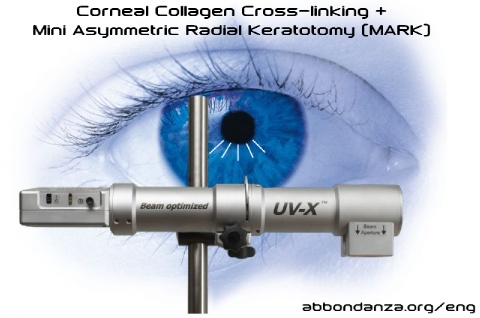COMBINED TECHNIQUES FOR KERATOCONUS TREATMENT: CORNEAL COLLAGEN CROSS-LINKING + MARK
 New modalities of treatment continue to be applied and studied for the conservative treatment of keratoconus worldwide.
New modalities of treatment continue to be applied and studied for the conservative treatment of keratoconus worldwide.
It is well known that these treatments have precise limitations regarding the achieved goals, these limits must be accepted because they are specific to each treatment. However, in order to benefit from the diverse goals of different treatments, it has been seen that it is possible to combine a number of techniques when indicated by the patients conditions.
Combination treatments consisting of Corneal Cross-linking (CXL) and ICRS are often in use in the USA. This combined treatment associates the improvement of visual acuity following adoption of the intracorneal ring with the increase of corneal resistance obtained with CXL treatment. Combined treatments using Cross-linking and LASIK are also used, especially in the U.S.
Combined protocols adopting CXL and PRK or CXL and Phakic Intraocular Lens implantation can be very useful, if the patient’s conditions allow them. These are more often used in Europe.
Dr. Abbondanza uses, when medically necessary, either the CXL+PRK or the CXL+Phakic Intraocular Lens implantation treatment. Dr. Abbondanza, however, is also the inventor of another combined treatment, that is the CXL+MARK protocol, know as the “Rome Protocol”. When indicated, micro-incisions from MARK surgery allow a reduction of corneal curvature and astigmatism along with a significant improvement of visual performance, while the association of Corneal Cross-linking allows the necessary increase of corneal resistance, thus stabilizing the cornea. A clinical study, published in 2016 by scientific journal Acta Medica International (click here to read it), showed that Dr. Abbondanza’s MARK+CXL combined protocol, knows as the “Rome Protocol”, produces an average reduction in corneal curvature of 3,7D and a significant decrease of corneal aberrations, along with the halting of the disease itself.
Summarizing, there are 5 combined protocols for the treatment of keratoconus:
- CXL + PRK
- CXL + Phakic Intraocular Lens implantation
- CXL + LASIK
- CXL + ICRS
- CXL + MARK
Each combined protocol needs to meet the ophthalmic surgeon’s approval after a thorough medical examination, as there is no treatment that is always good for every patient.
.
